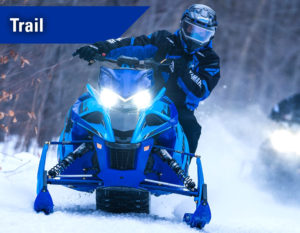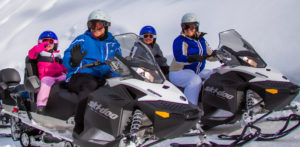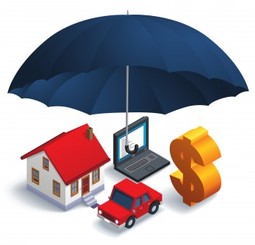Snowmobile Safety Tips – December 2019
Snowmobile Safety Tips 
It’s that time of year and winter has arrived, and the snow has begun fall. If you own a snowmobile than you are ready to start riding and enjoying your time on the snowmobile trails. While snowmobiling can be exhilarating experience and fun during the winter season, it can also be a very dangerous if proper safety precautions are not taken. To protect you and keep you safe here are some important snowmobile safety tips.
- Take a snowmobile safety course. Have you taken your safety course? While many states require a snowmobile certificate each state has its own set of rules, laws and regulations. A snowmobile safety course will instruct you on how to ride safely and responsibly, as well as teach you the rules. It is especially essential and helpful for those first-time drivers or riders. You will learn riding techniques that will help you operate the snowmobile and avoid any hazards.
- Check the weather forecast and the trail conditions. Before heading out on the trail it’s always a good idea to check the weather forecast and trail conditions. You do not want to put yourself or someone else in danger if the trail is frozen, the wind chill is too low, or a blizzard with white out conditions is in the forecast. If this is the case, then you should plan your ride for another day. By checking the weather, it helps you select the proper clothing for the day.
- Wear proper cloths and protective gear. Staying warm and dry during your ride is essential to staying safe and making your ride more enjoyable. Wear a snowmobile suit, which consists of a jacket and insulated bibs. Make sure you are dressed in layers under your snowmobile suit. Make sure you stay away from cotton in case it gets wet, if that happens it will freeze and that will not be good. Choose polyester blends to hold moisture away from your body. If you do not have a full-face helmet, make sure you wear goggles or a face shield, socks (NO cotton), waterproof gloves, winter hat, face-mask and winter boots. Always wear a DOT-approved helmet, not only to keep you warm but to protect your head from injury. Make sure children have a helmet that properly fits them.
- Inspect your snowmobile before your ride. Before you hit the trail make sure your snowmobile is running properly. Make sure you have your owner’s manual handy on your ride for extra safety. It’s important to follow the recommended service schedule to keep it maintained and running smoothly. Make sure you check fuel and oil levels, battery, brakes, drive belt, skis, throttle, handlebars, headlights and taillights before your ride. Before you take off on your snowmobile, make sure you allow your snowmobile time to run for at least a minute to warm up.
- Bring a buddy. Riding with a friend or in a group is fun, but also safer, especially on trails you have never taken before. It’s always a good idea to have someone with you in case your snowmobile breaks down or you get into an accident. Make sure you tell a family member or a friend your plans and route for your ride, just in case you get stranded. FYI, cell phones don’t always work in remote areas.
- Carry a first-aid kit, emergency kit and repair kit. It’s essential to carry a basic first-aid kit in snowmobile in case of injury. Your kit should include disinfecting wipes, bandages, hand sanitizer, gauze, adhesive tape and Band-Aids. In addition, carry an emergency kit with waterproof matches, flashlight, compass, map, blanket, water, snacks and a knife. A repair kit should include duct tape, tools, spare belt, tow rope, spark plugs and pry bar.
- Stay Alert. It’s important to be observant and watch for obstacles in your path, such as rocks, fallen trees, barbed wire fences, ditches, open water, other snowmobiles, snowbanks, animals, hikers and skiers.
- Avoid frozen rivers. It’s impossible to gauge the thickness of ice. Ice can easily crack and give way under your snowmobile.
- Do not speed. By driving at a moderate speed, it will help you to react quickly to a situation on the trail and will help you to avoid an accident. Many trails have posted speed limits to follow.
- Stay on the trail. Make sure you stay on the marked trails as they have been groomed for you and are less likely to have any dangerous hazards. Going off the trail could result in accidents as you are treading in unfamiliar territory, and you may also get lost and not be able to find your way back. Many public trails run close to private property. Unless you have received permission from the landowner, stay on the marked trail. Failure to comply may result in a trail being closed to the public in the future. Be a responsible rider by following the posted signs and trail markers.
- Driver should be the age of 16 or older. The American Academy of Pediatrics strongly recommends that children under the age of 16 do not operate a snowmobile. The reason is due to the lack of skills needed to safely operate the vehicle and due to their stature can be easily injured.
- Children under the age of six should never ride as a passenger according to the American Academy of Pediatrics. The snowmobile can ride rough and it takes a strong person to hold on tight, especially for long periods of time. Children under the age of six lack this strength.
- Do not overload your snowmobile. Make sure you review your manufacturer’s guide for the approved number of passengers and also the amount of weight it may be able to carry. Exceeding these maximums either from an additional passenger or heavy gear can increase your chances of an accident or injury.
- Never drink and drive.
It’s the law. Just like driving a vehicle, operating a snowmobile while under the influence can lead to delayed response and you could cause an accident and injury to yourself or someone else.
- Do not pull people on anything behind your snowmobile. Snowmobiles were not designed to pull sleds, skiers or saucers and it’s unsafe.
We hope these snowmobile safety tips lead to a fun and safe riding experience. If you’re looking for snowmobile insurance or shopping for new snowmobile insurance give us a call, we would be happy to quote your snowmobile insurance. We specialize in snowmobile insurance coverage tailored to meet your unique needs. 

